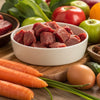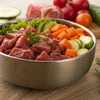How to Travel with Raw Dog Food: A Comprehensive Guide for Pet Owners
- Houndsy
Table of Contents
- Introduction
- Planning Ahead: Know Your Dog's Needs
- Choosing Your Storage Solutions: Coolers and Containers
- Staying Safe: Food Handling and Hygiene
- On-The-Road Feeding Tips
- Alternative Meal Options: Flexibility Matters
- Finding Local Suppliers on the Go
- Cleaning and Maintenance During the Journey
- Keeping Your Dog Comfortable During Travel
- Conclusion
Introduction
Did you know that over 35% of pet owners are switching to raw diets for their dogs, primarily due to the perceived health benefits? If you're one of those pet parents passionately committed to providing your furry friend a raw diet, the thought of traveling might spark a mixture of excitement and concern. Traveling with your dog can be a joyful experience, but it also brings unique challenges—especially when it comes to maintaining their diet.
As passionate pet owners ourselves, we understand the desire to keep our dogs happy and healthy, even while on the go. This blog post will guide you through everything you need to know about traveling with raw dog food, including preparation, storage options, and helpful tips that ensure your dog remains nourished and satisfied during your adventures. By the end, you'll gain a thorough understanding of how to integrate raw feeding into your travel plans, allowing you to focus on creating wonderful memories with your furry companion.
We’ll cover subjects like effective meal planning, choosing the right containers, maintaining food safety, and creative alternatives for traveling. So, grab your dog's leash and let's embark on this journey together!
Planning Ahead: Know Your Dog's Needs
One of the most critical elements of traveling with raw dog food is planning. Raw diets often revolve around specific nutritional goals tailored to your dog's individual needs. If you've been feeding your dog raw food for a while, you likely know exactly how much they need each day, but don’t forget to factor in the specifics of your trip.
Calculate Daily Food Requirements
First things first: determine how much raw food your dog requires for the duration of your trip. This means knowing whether they're on a diet of large butcher blocks of meat or smaller, pre-portioned patties. It’s always wise to pack a little extra food—about a day’s worth—just in case of emergencies such as delays or last-minute changes in plans.
Portion Control
To make feeding easier during travel, consider pre-portioned meals. This allows you to eliminate any mess and minimizes the time needed to dig through your cooler, especially if you're in a hurry. Smaller, portion-sized containers not only help in the preparation but also make cooking and thawing quicker and safer, which is crucial for maintaining a raw diet.
Choosing Your Storage Solutions: Coolers and Containers
When it comes to storing raw dog food during your travels, your choice of cooler and containers can make a significant difference in the quality and safety of the food.
The Right Cooler
Investing in a quality cooler designed specifically for pet food can save a lot of hassles. Avoid using the same cooler for both human food and your dog's food, as this can lead to cross-contamination and temperature fluctuations. Instead, consider the following:
-
Interior Space: Make sure it can securely hold all of your dog's meals without extra space, which can help keep the temperature down. Research the dimensions of your cooler options based on how much food you’ll be carrying.
-
Ice Packs: Use reusable ice packs to keep the food fresh. For extended trips, buying ice every day can help maintain a lower temperature. Remember, thawed raw food can last about two to three days if stored correctly.
Containers Matter
Select airtight and leak-proof containers to store your dog’s meals securely. Utilizing resealable bags or vacuum-sealed containers can help prevent air from spoiling the food and making cleanup a breeze.
-
Portion Control: Remember to measure out your dog’s meals into smaller containers to aid in easier thawing and serving.
-
Labeling: Clearly label containers with the date and type of food to ensure the oldest items are used first, thus minimizing wastage.
Staying Safe: Food Handling and Hygiene
Traveling with raw dog food also entails prioritizing hygiene and food safety.
Prevent Cross-Contamination
Using separate cutting boards and utensils for your dog’s food will help to avoid cross-contamination. This precaution is essential for protecting both your pets and yourself from potential foodborne illnesses.
Proper Handling Techniques
-
Hands: Always wash your hands before and after handling the raw food. This simple step is crucial to maintaining hygiene.
-
Meal Cleanup: Clean any utensils and bowls immediately after your dog finishes eating to prevent bacterial growth.
On-The-Road Feeding Tips
While on the road, several strategies can ensure your dog continues on their raw diet without disruptions.
Hydration is Key
Be mindful of your dog’s hydration levels, especially during trips, as dogs can easily become dehydrated. Bring plenty of fresh water and monitor their drinking to align with their normal consumption.
Meal Times
Establish a feeding routine similar to what your dog is accustomed to at home, but be flexible. Dogs often feel stress when traveling, so maintaining a consistent schedule can provide comfort.
Keep It Cool
Always store your cooler away from direct sunlight and monitor the temperature to ensure it remains consistently cold. If possible, use a thermometer designed for coolers to verify the internal temperature.
Alternative Meal Options: Flexibility Matters
Sometimes, traveling with raw dog food may require adaptations. Here are some creative solutions for those situations where keeping the raw food requires too much hassle.
Dehydrated or Freeze-Dried Food
Consider keeping freeze-dried or dehydrated dog food as a backup. These options are incredibly lightweight, shelf-stable, and simply require water for rehydration before feeding. They can serve as a nutritious alternative when fresh raw food is unavailable.
Cooked Meals in a Pinch
If refrigeration or raw food storage isn't feasible, you can switch to lightly cooked meals. Cooking significantly reduces the risk of foodborne bacteria while preserving much of the nutritional value.
High-Quality Kibble
As a last resort, high-quality kibble that aligns with your dog’s dietary needs can be considered. We often suggest brands that specialize in natural ingredients to ensure your pet still receives a balanced meal while traveling.
Finding Local Suppliers on the Go
If you're traveling to a new area, try to research beforehand to locate local pet food suppliers that sell raw dog food. Many independent pet stores or local farms may stock options for your pet, allowing you to stock up as needed.
Cleaning and Maintenance During the Journey
When feeding your dog raw food while traveling, having the right cleaning materials is essential to ensure hygiene. Bring pet-friendly cleaning wipes to wipe your dog’s mouth after mealtime, especially if young children are present. This step is crucial for preventing any unintended cross-contamination.
Keeping Your Dog Comfortable During Travel
Traveling can be overwhelming for some dogs, especially those that may struggle with anxiety. Consider these tips for keeping your dog relaxed on your journey:
Comfort Items
Bringing along your dog’s favorite toys or blanket can help soothe them during travel. These familiar items can provide comfort and reduce stress in unfamiliar surroundings.
Frequent Breaks
Planned Stops: Make sure to plan pit stops for bathroom breaks and to give your dog a chance to stretch their legs. This is especially crucial for energetic dogs who need opportunities to burn off excess energy.
Travel Safety
Utilize a car harness or crate to ensure your pet remains safe during travel. This practice keeps both you and your dog secure while driving and can prevent accidents.
Conclusion
Traveling with your dog doesn’t have to mean compromising on their raw diet. With thorough planning, smart storage solutions, and creative meal alternatives, it can be a smooth process. Whether you choose to prepare your dog’s meals at home, utilize freeze-dried options, or procure fresh food along the way, remember to prioritize your dog’s health and well-being during your travels.
By thoughtfully integrating their nutritional needs into your travel plans, you're not just elevating your dog's feeding ritual; you’re enhancing the entire travel experience for both of you. So next time you hit the road, consider checking out the Houndsy Kibble Dispenser for a stylish and functional solution to your dog feeding needs. Safe travels!
FAQ
Q1: How long can raw dog food stay safe in a cooler during travel?
A1: Raw dog food can stay safe in a well-maintained cooler for up to 2-3 days, depending on the cooler's efficiency and whether ice packs are utilized. Always check the food for freshness before serving.
Q2: Can I use freeze-dried food instead of raw while traveling?
A2: Yes! Freeze-dried food is an excellent alternative that is lightweight, requires no refrigeration, and simply needs water to prepare.
Q3: What precautions should I take while handling raw dog food?
A3: Always wash your hands, use separate utensils for raw food, clean your dog’s feeding area thoroughly, and label food containers for easy identification.
Q4: Is it okay to switch my dog’s diet to cooked meals temporarily?
A4: Yes, switching to lightly cooked meals can be an acceptable alternative while traveling, but ensure to maintain a proper balance of nutrients.
Q5: Where can I find raw dog food on the go?
A5: Research local pet food suppliers or grocery stores in your travel area ahead of time. Many carry a range of raw dog food options.












